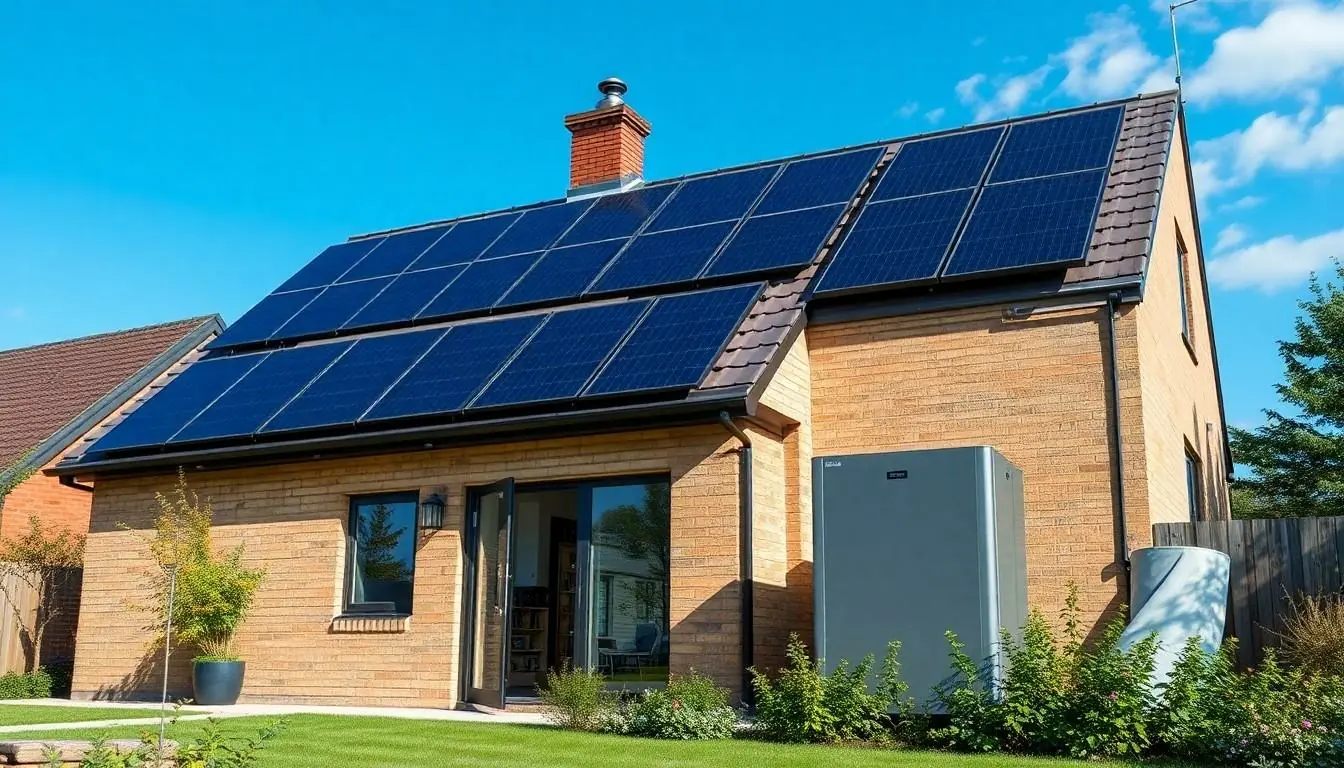In a world where energy prices seem to rise faster than a cat on a hot tin roof, home battery storage in the UK is fast becoming the superhero of household energy solutions. Imagine harnessing the sun’s rays during the day and using that power to keep your lights on at night—no cape required! With the right home battery system, homeowners can finally say goodbye to the dreaded energy bills and hello to energy independence.
But it’s not just about saving money; it’s about being smarter with energy. Home battery storage systems are like that reliable friend who always has your back—ready to lend a hand when the grid goes down or when those pesky peak charges hit. As the UK shifts towards a greener future, embracing this technology could make anyone feel like they’re not just part of the solution but the life of the party.
Table of Contents
ToggleOverview of Home Battery Storage UK
Home battery storage systems in the UK have gained significant traction as homeowners look for cost-effective solutions to rising energy prices. These systems enable users to store solar energy generated during the day for nighttime use, maximizing the benefits of renewable energy sources.
Energy independence plays a pivotal role in the appeal of these technologies. Home battery storage allows for reduced reliance on the grid, especially during peak demand periods when electricity rates surge. As a result, homeowners can enjoy substantial savings on their electricity bills.
Reliability stands out as another critical advantage. During power outages, these systems provide a backup power source, ensuring essential appliances remain operational. Moreover, they help stabilize energy costs by allowing homeowners to draw power from stored energy when prices are at their peak.
A growing number of homeowners are recognizing the environmental impact. Transitioning to home battery storage aligns with the UK’s goal of reducing carbon emissions and promoting sustainable living. Incentives and programs from the government further support the adoption of these systems, making them more accessible and affordable.
Installation options for home battery systems are diverse, catering to various needs and preferences. Many homeowners opt for systems that integrate seamlessly with existing solar panel installations. Advances in technology have also led to improved battery efficiency and capacity, enhancing overall performance.
Overall, home battery storage represents a significant step forward in energy management for UK households. Its benefits extend beyond cost savings to encompass reliability and environmental consciousness, making it a vital component in the transition toward a sustainable energy future.
Benefits of Home Battery Storage

Home battery storage systems offer numerous benefits for homeowners in the UK. They enhance energy efficiency while contributing to sustainable living.
Cost Savings
Cost savings represent a significant advantage of home battery storage. By storing solar energy during the day, homeowners reduce their reliance on the grid at peak times. Users often see decreased electricity bills as they draw from stored energy instead of purchasing expensive energy from utility companies. According to recent studies, homeowners can save up to 70% on energy costs with effective storage solutions. Incentives further reduce the initial investment, making these systems financially enticing for those considering renewable energy.
Energy Independence
Energy independence allows homeowners to take control of their power supply. Storing energy from solar panels provides an alternative to relying on fluctuating energy prices. Residents benefit during outages, ensuring essential devices remain operational. This independence diminishes vulnerability to grid failures and market fluctuations, fostering a sense of security. Greater autonomy in energy management empowers homeowners to make informed decisions about their consumption and long-term sustainability goals.
Environmental Impact
Environmental impact plays a crucial role in the appeal of home battery storage. Transitioning to cleaner energy sources aligns with the UK’s commitment to reducing carbon emissions. By utilizing renewable energy, homeowners contribute to global efforts against climate change. Home battery systems enhance energy efficiency, reducing the overall carbon footprint of households. Increased adoption of these systems supports a greener future, aligning with governmental targets for sustainable living and resource conservation.
Types of Home Battery Systems
Home battery systems come in various types, with each offering unique advantages for energy storage. Understanding these options helps homeowners make informed choices.
Lithium-Ion Batteries
Lithium-ion batteries dominate the home battery market due to high energy density and efficiency. They charge quickly, providing reliable energy when solar power isn’t available. Lifespan often exceeds 10 years, with many models offering warranties that reflect their durability. Homeowners enjoy lightweight installations and compact designs, making them easier to integrate into existing setups. Additionally, these batteries enable a higher number of charge cycles compared to traditional options, enhancing their overall value.
Lead-Acid Batteries
Lead-acid batteries represent a well-established technology in energy storage solutions. These systems typically come as flooded or sealed versions, catering to different user preferences. While they are heavier and bulkier than lithium-ion counterparts, they remain cost-effective for those looking to minimize initial investments. Lifespan averages around 5 to 7 years, which may require earlier replacements. Despite shorter lifespans, lead-acid batteries can still efficiently support power needs, especially in off-grid applications. Homeowners appreciate their long history and widespread availability, making maintenance simpler.
Installation Process
The installation of home battery storage systems involves several key stages to ensure optimal functionality. Understanding these steps assists homeowners in making informed decisions.
Site Assessment
A comprehensive site assessment lays the foundation for a successful installation. Technicians evaluate factors such as roof orientation, shading, and available space for battery placement. This assessment identifies the system capacity needed based on energy consumption patterns. Homeowners receive tailored recommendations for the most suitable battery technology and size. Additionally, local regulations and grid connectivity requirements are considered during this stage. A thorough evaluation guarantees that the selected system aligns with both the homeowner’s needs and local standards.
Professional Installation vs. DIY
Choosing between professional installation and a DIY approach influences the effectiveness and safety of the battery system. Professional installers bring expertise, ensuring compliance with local codes and regulations. They handle the complexities of wiring and configuration, which reduce the risk of errors. DIY installation can save money, but it carries the risk of improper setup and diminished system performance. Homeowners must weigh the potential savings against the benefits of expert guidance. Expertise ensures that the installation is efficient, increasing the system’s life span and output.
Choosing the Right Home Battery
Selecting the appropriate home battery storage solution requires careful consideration of specific factors. Homeowners must evaluate aspects like capacity and brand to make informed decisions.
Capacity and Size Considerations
Capacity plays a crucial role in determining a battery’s effectiveness. Measured in kilowatt-hours (kWh), this metric indicates how much energy a battery can store. For a typical household, a capacity of 5 to 15 kWh often meets daily energy needs. Seasoned users often scale up storage for greater autonomy from the grid. Size also matters; homeowners must ensure available space accommodates the battery system without hindering functionality. System weight and dimensions factor into installation, especially if adding to existing solar setups. Selecting the right capacity aligns with personal energy usage patterns, leading to optimized performance.
Brand Comparisons
Brand choices influence not only battery performance but also longevity and warranty options. Renowned brands such as Tesla, Sonnen, and LG Chem dominate the market with high-quality offerings. Tesla’s Powerwall, recognized for its efficiency, features a capacity of 13.5 kWh and integrates seamlessly with solar systems. Sonnen’s ecoLinx emphasizes sustainability and energy management, providing customizable features for different user preferences. Comparing warranties reveals significant differences; some brands offer extensive coverage, while others provide limited time frames. Homeowners should carefully assess these aspects to ensure their chosen system meets both current and future energy requirements.
Home battery storage systems are transforming the energy landscape in the UK. They offer homeowners a practical solution to rising energy costs while promoting sustainability. By harnessing solar energy for later use, these systems not only enhance energy independence but also provide a reliable backup during outages.
With advancements in technology and supportive government initiatives, adopting home battery storage is becoming increasingly feasible. Homeowners can choose from various battery types to find the best fit for their needs. Investing in these systems represents a significant step toward a more sustainable and cost-effective energy future. Embracing home battery storage isn’t just about savings; it’s about empowering households to take control of their energy consumption and contribute to a greener planet.

